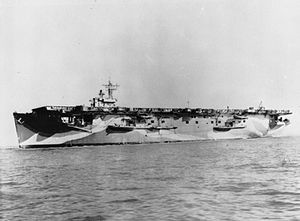HMS Stalker (D91)
 HMS Stalker January 1943
| |
| History | |
|---|---|
| Name | USS Hamlin |
| Namesake | Hamlin Sound in South Carolina |
| Builder | Western Pipe and Steel Company |
| Laid down | 6 October 1941 |
| Launched | 5 March 1942 |
| Fate | Transferred to Royal Navy 21 December 1942 |
| Name | HMS Stalker |
| Commissioned | 21 December 1942 |
| Decommissioned | 29 December 1945 |
| Stricken | 20 March 1946 |
| Fate | Sold as a merchant ship; scrapped 1975 |
| General characteristics | |
| Class and type | Attacker-class escort carrier |
| Displacement | 14,400 tons |
| Length | 491 ft 6 in (149.81 m) |
| Beam | 105 ft (32 m) |
| Draught | 26 ft (7.9 m) |
| Propulsion | Steam turbines, 1 shaft, 8,500 shp (6,300 kW) |
| Speed | 18 knots (33 km/h; 21 mph) |
| Complement | 646 |
| Armament |
|
| Aircraft carried | 20 |
| Service record | |
| Operations: |
|
USS Hamlin (CVE-15) was one of a large group of
San Francisco, California, on 5 March 1942, as AVG-15, aircraft escort vessel. She was sponsored
by Mrs. William H. Shea. Her designation was changed to ACV-15, auxiliary aircraft carrier, 20 August 1942, and she was acquired and simultaneously transferred to the United Kingdom 21 December 1942. Hamlin's designation was changed to CVE-15, escort aircraft carrier, 15 July 1943.
Renamed HMS Stalker (D91), the escort carrier played a vital part in allied operations in the
Navy Register 20 March 1946 and sold to Waterman Steamship Corp. of Mobile, Alabama, 18 December 1946. Waterman in turn sold her to the Netherlands in August 1947 where she was converted to the merchant ship Riouw. Later renamed Lobito in 1968, she was scrapped in Taiwan
in September 1975.
Design and description
There were eight
Western Pipe & Steel shipyards in the United States, both building four ships each.[1]
The ships had a complement of 646 men and accommodation of Royal Navy mess hall control food. The separate messes no longer had to prepare their own food, as everything was cooked in the galley and served cafeteria style in a central dining area. They were also equipped with a modern laundry and a barber shop. The traditional hammocks were replaced by three tier bunk beds, eighteen to a cabin which were hinged and could be tied up to provide extra space when not in use.[2]
The ships dimensions were; an
deep load.[3] Propulsion was provided by four diesel engines connected to one shaft giving 8,500 brake horsepower (6,300 kW), which could propel the ship at 17 knots (31 km/h; 20 mph).[4]
Aircraft facilities were a small combined bridge–flight control on the
anti-submarine aircraft.[3]
References
Bibliography
- Cocker, Maurice (2008). Aircraft-Carrying Ships of the Royal Navy. Stroud, Gloucestershire: The History Press. ISBN 978-0-7524-4633-2.
- Poolman, Kenneth (1972). Escort Carrier 1941–1945. London: Ian Allan. ISBN 0-7110-0273-8.
External links
Wikimedia Commons has media related to HMS Stalker (D91).
